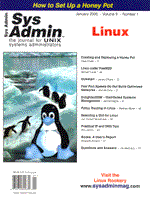
New MessagesThis month's letters correct a few errors that crept into past issues and provide some useful additional information. Thanks to everyone who wrote in! --AA
From: Paul Weber (pweber@friendlyworks.com)
In July you published a time syncronizing script on page 66. In order to make the script work with Linux (Red Hat 6.0, kernel 2.2.12), I had to make a change. The variable touch_format needs to be:
$touch_format=sprintf("%02.2s%02.2s%02.2s%02.2s%02.2s%02.2s\.%02.2s",
$mon,$mday, $hour,$min,$cent,$year,$sec);
Thanx for a neat little utility! -- Paul
From: Vik Olliver (http://olliver.penguinpowered.com)
Just read the article “Using Screen” on p.23 of the October 1999 issue. It looks like a very nice utility for text-mode interaction, but there is a free graphical equivalent. At my employer's ECONZ (http://www.econz.co.nz), we make extensive use of a utility called VNC. This is available free (OSS) from AT&T in the United Kingdom on http://www.uk.research.att.com/vnc/. It allows remote graphical terminals to control other graphical terminals. A terminal can be running X under Linux, Solaris, OSF1, or even any flavour of Windows (including WinCE), MacOS, and even a Palm Pilot. Several consoles can connect simultaneously in either direction. Because the UNIX VNC session is served from a host, the client can disconnect, go home, log in, and call up the session as it was when they left off. It allows me to control NT servers in a room upstairs, run GUI Linux boxes with no screen attached, or do remote maintenance of large corporate systems in Australia. More prominence needs to be given to this excellent tool. Vik
From: Jim McKinstry (jrmckins@yahoo.com)
I noticed a couple of problems in the November 1999 issue. In the “Controlling Spam” article, on p.10, there is a crontab entry that we are instructed to add. There are 2 problems with this entry:
1. It is commented out so it will never run. 2. The author lists every minute that it is to execute.
I think the entry would be more clear if it were written:
* * * * * root nice ... Also, in my Q&A article, on p.67, there is a command:
ufsdump (ufsdump stuff here) > /tmp/output.file two>&1 that should read:
ufsdump (ufsdump stuff here) > /tmp/output.file 2>&1 There is also a command:
ufsdump (ufsdump stuff here) 1> /tmp/output.file two>/outputtwo.file that should read:
ufsdump (ufsdump stuff here) 1> /tmp/output.file 2>/outputtwo.file And finally, there is a command:
ufsdump (ufsdump stuff here) >& /dev/null that should read:
ufsdump (ufsdump stuff here) >& /tmp/output.fileSorry about that. Thanks! Jim McKinstry |